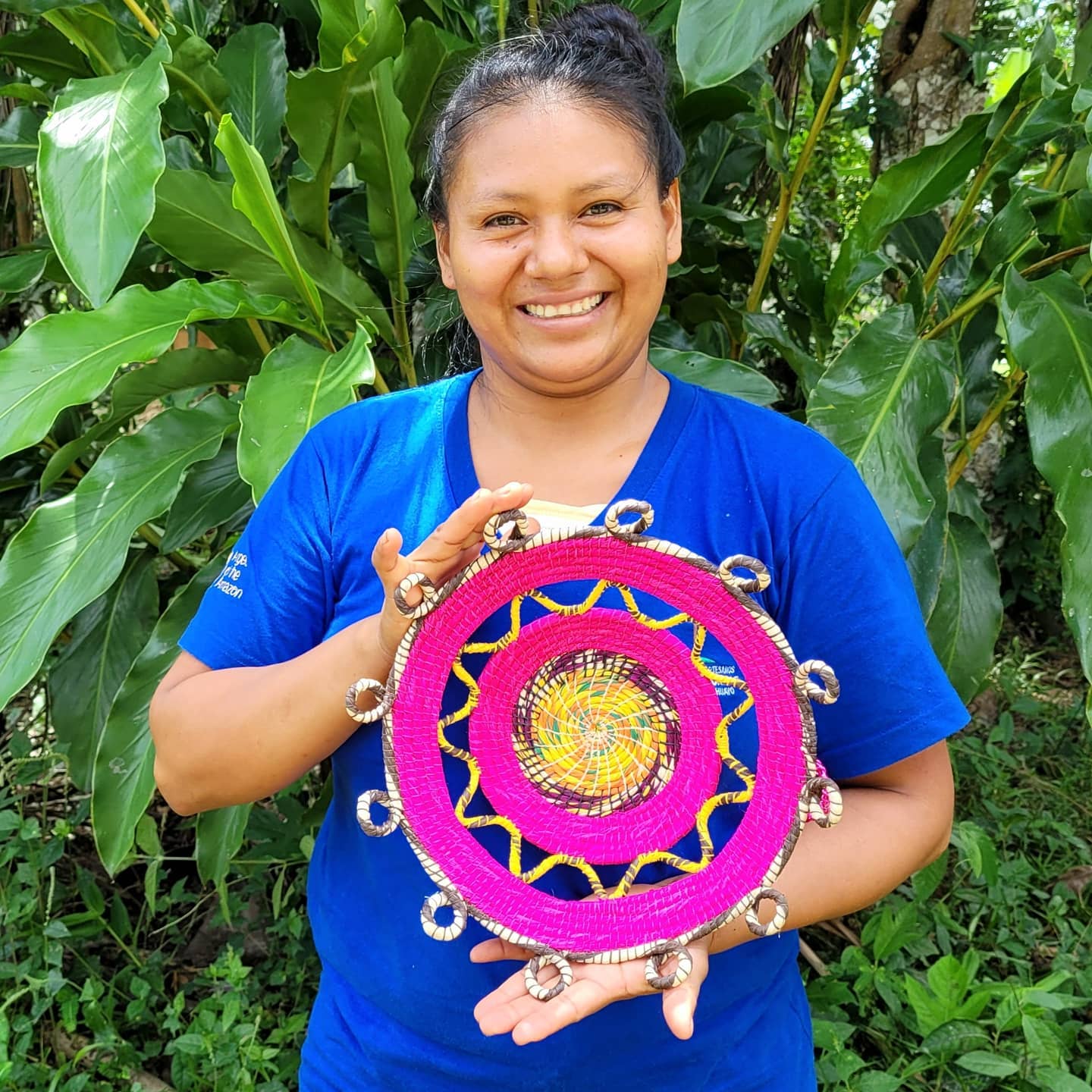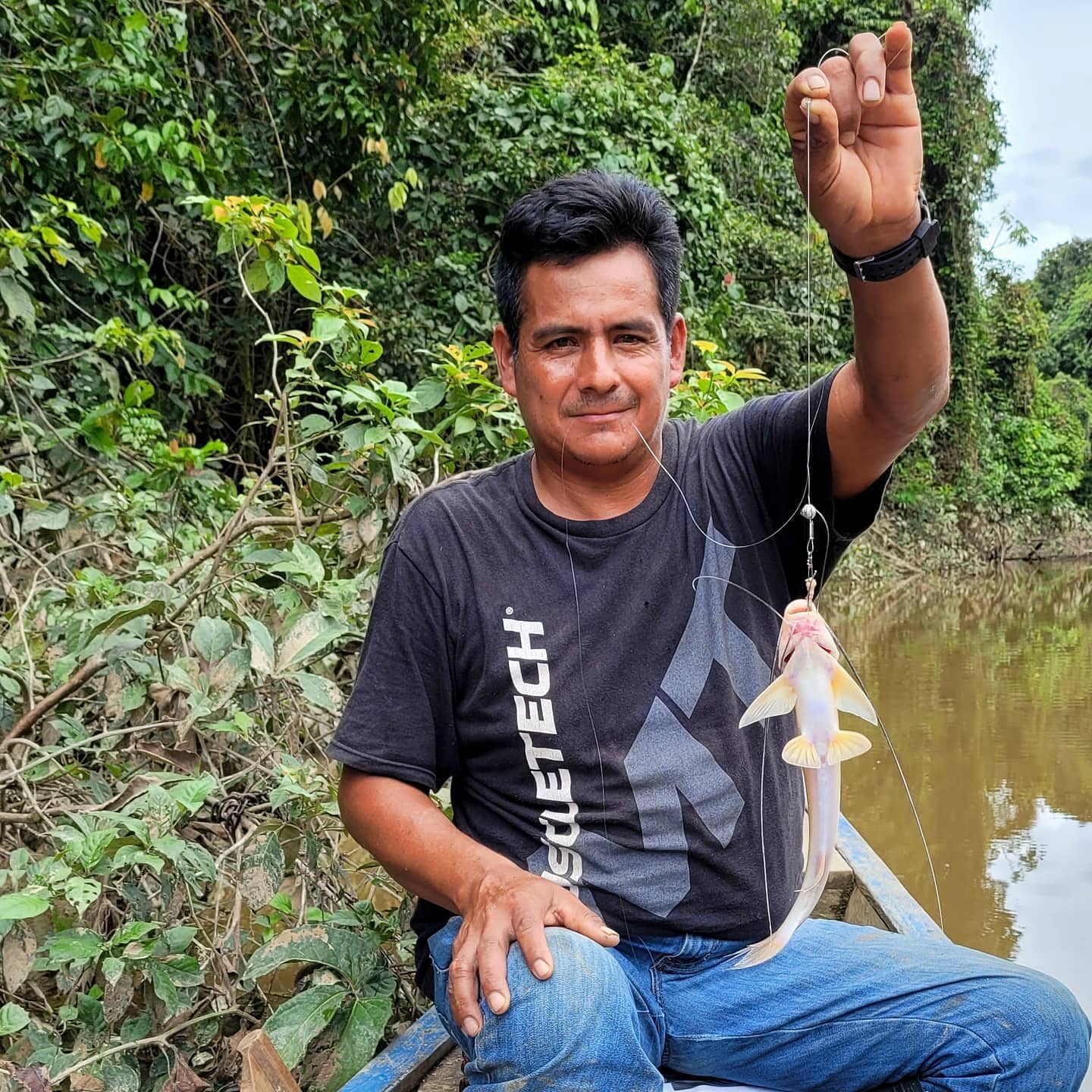Story and photos by Campbell Plowden, Executive Director, Amazon Ecology
PIECES OF DEVELOPMENT AT PUCA URQUILLO
We had a smooth trip from Brillo Nuevo to Puca Urquillo. A few women were washing their clothes in the river on the broken remains of a cement staircase going up the hill to the village. Docked at the base of the Bora side of this twin village was a large floating maloca. It was supposedly built to be an attractive platform to host tourists that would arrive in fancy boats to enjoy a full cultural experience visiting the Bora native village. Artisans would be able to sell them lots of handicrafts.
No tourists group ever came to this maloca, though. When COVID hit in March of 2020, Peru quickly shut down all incoming and outgoing international flights. The pandemic hit Peru hard, and Puca Urquillo was no exception. We heard about 95% of the village was sick with the virus at some point, and five people died. We did use this floating dock a couple of times to drop off sealed bags of food and medicine in a boat and then left the area before artisan leaders came down from the village to retrieve the aid packages.
Walking up to the village, we ran into our artisan friend Benjamin with his young son on his shoulders by an old bulldozer which had been used far longer as a weed covered jungle gym for kids than it had ever been used for some long-forgotten construction project.

We next checked in with Nicolas and other artisans from the Huitotos side about their progress using the computer we had donated to their association at the end of the computer and writing workshop they had attended in Iquitos in early November. It was good to see they were taking good care of the machine.
We were disappointed but not totally surprised to find this actually meant that it had been kept safely in its box without anyone using it. After Yully talked with them, it was clear they needed a follow-up session with our communications coordinator Tulio to get enough confidence to practice what they had learned in the workshop. Hopefully this computer will provide the artisans with at least a few years of productive service.

THE BROKEN BRIDGE TO PUCA URQUILLO
Up until 2016, the most practical way to get from Puca Urquillo to the town of Pebas was a 45-minute trip in a motor canoe. An enterprising mayor of Pebas finally managed to get enough funding from the regional government to build a narrow cement path between these two locations. This was not a trivial task because it required building one steel and cement suspension bridge and 20 wooden bridges to cross the numerous gorges and streams along the route.
This path suddenly made it possible to travel by motorcar from one end to the other in just 20 minutes. If two motorcars met going opposite directions, one courteously pulled off the path to let the other one pass. Children could walk from one end of the Santa Lucia de Pro to the school on the other end and practice math problems with chalk on the sidewalk.

This path also opened up the forest along the route to more homes and more associated forest clearing. It was at least good to see a chambira palm tree heavily laden with fruit was left standing. These seeds could provide abundant seedlings for the next generation of artisans harvesting chambira leaves to weave crafts.
As frequently happens with public works projects in Peru, though, building something and building something well and maintaining it are different matters. Several months after the "road" was opened, one of the longer wooden bridges near Puca Urquillo collapsed in the middle. Motorcars from Pebas could only go this far before they had to discharge their passengers to cross the stream below with any baggage and either walk or try to get a motorcar on the other side to complete their journey.
It took several years before another mayor came up with the funds to fix this bridge. The route is now passable again in one trip, but there are some rotting boards and one scary place without any side railing. No one seems to know who is responsible for repairing such hazards. When approaching this gap, I try to look straight ahead and just pray the motorcar doesn't suddenly slide off its straight path and discharge its passengers into the ravine below.

WHAT’S THE RIGHT NUMBER OF ARTISAN ASSOCIATIONS?
On our way back from Brillo Nuevo, we stopped again at Puca Urquillo to meet with the artisans and started with the Huitoto. It was good to have Isideo, the president of the community present, since he was supportive of our programs and joined an AVP workshop a few years ago.
The artisans were enthusiastic to continue our workshops to help them improve their crafts, strengthen their organization and plant more chambira trees. Their main challenge was having an association with over 40 members with only a dozen who were active in trainings and filling orders. The leaders were stumped about how to handle this imbalance.
I admired their desire to have an inclusive group, but I thought it was better to start with a small group that functioned well rather than struggle to manage a large group that had problems cooperating.
The dynamic with the Bora artisans was quite different. A few years ago, we committed to help artisans formally register their associations so they could increase their access to government grants, training workshops and craft fairs in Iquitos and beyond.
We only envisioned doing this once in each community, but three groups in Puca Urquillo Bora now need different amounts of legal, leadership, marketing, and chambira management support. We also need to figure out how to manage craft orders with multiple groups of artisans in the same community.
Fortunately there are other groups who also support this process with training and/or financial resources. Some artisans sell most of their crafts to other wholesale craft buyers so we do not feel the weight of being the major buyer here as we do in a few places.
We actually had a very amiable meeting with artisans from all three groups, reviewed some crafts delivered from a previous order and discussed ideas for a few new crafts including chambira earrings and coasters. It was exciting to see one artisan’s first attempt to make a lined chambira tablet holder.
I appreciated being able to get a new photo of myself with some of our artisan friends from this community.





